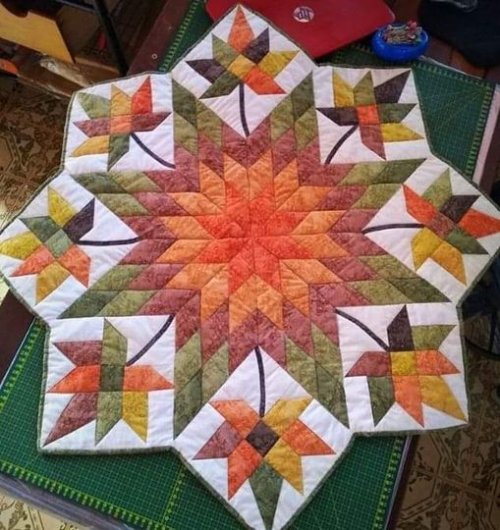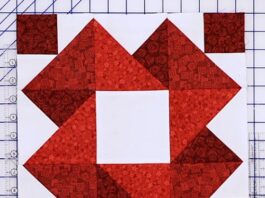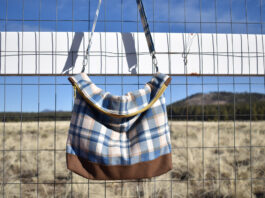If you’re a quilting enthusiast looking for a creative project that blends classic beauty and intricate design, then the Lone Star and Maple Leaf Quilt Combo: A Stunning Free Pattern is just what you need!
This pattern brings together two timeless quilt designs—the radiant Lone Star and the iconic Maple Leaf. Whether you’re a beginner or an experienced quilter, this project offers a satisfying challenge and a rewarding result.
In this blog post, we’ll dive deep into this unique pattern, how you can create it, and why it’s a must-try for quilting lovers.

The Lone Star quilt pattern, with its dazzling eight-pointed star, has been a favorite among quilters for generations. When paired with the Maple Leaf design, which symbolizes the beauty of nature, the combination creates a visually stunning and meaningful quilt.
Best of all, you can get started on this free pattern today, which makes it even more exciting! Whether you’re crafting a cozy blanket for the colder months or creating a cherished family heirloom, this quilt is sure to impress.
In this blog, we’ll explore the components of the Lone Star and Maple Leaf Quilt Combo: A Stunning Free Pattern, provide tips and tricks to make your quilting process smoother, and answer common questions quilters often have about this pattern. Let’s jump into it!
1. Understanding the Lone Star Quilt Pattern
The Lone Star pattern, also known as the Star of Bethlehem, is one of the most recognizable quilt designs. Its striking appearance comes from the intricate arrangement of diamond-shaped pieces that radiate outward from the center, creating a dynamic starburst effect.
- History of the Lone Star: The Lone Star quilt pattern dates back to the 19th century and has deep roots in American quilting history. It was originally created by Native American tribes and later adopted by European settlers, becoming a staple in American quilt-making traditions.
- Design Structure: The Lone Star pattern typically consists of an eight-pointed star made from smaller diamond pieces. These pieces are arranged in concentric rings, with each layer expanding the star’s reach.
- Choosing Fabrics: To highlight the stunning geometry of the Lone Star, many quilters choose contrasting or gradient fabrics. Bold, saturated colors work wonderfully for creating depth, while softer hues offer a more delicate look.
- Cutting and Piecing: Precision is key when cutting the diamond shapes for the Lone Star pattern. The diamonds must be cut accurately to ensure that the points meet perfectly when piecing the quilt together.
- Quilting the Lone Star: The complexity of the Lone Star lies in the piecing, but once assembled, quilting can be done simply with straight-line stitching or more intricate free-motion quilting.
- Lone Star in the Combo Quilt: When combined with the Maple Leaf pattern, the Lone Star becomes a dazzling centerpiece, drawing attention to the quilt’s central theme of unity between traditional designs.
2. The Maple Leaf Quilt Pattern and Its Symbolism
The Maple Leaf quilt pattern is a timeless representation of the changing seasons and nature’s beauty. Its simple yet elegant design features blocks that resemble leaves, making it a perfect complement to the geometric sharpness of the Lone Star.
- Historical Significance: The Maple Leaf pattern has its origins in Canada, where the maple tree is a national symbol. It became a popular design in quilts as a tribute to nature and the connection to the earth.
- Design Elements: The Maple Leaf block is made from four smaller squares and triangles, forming a leaf with a distinct vein running through it. The block is versatile, allowing for various color combinations and arrangements.
- Choosing Colors for the Maple Leaf: When selecting fabrics for your Maple Leaf blocks, consider autumnal hues like reds, oranges, and yellows to reflect the natural beauty of fall leaves. For a more modern take, you can opt for greens, blues, or even monochromatic tones.
- Cutting and Piecing Maple Leaf Blocks: Like the Lone Star, precision is crucial when cutting and piecing the Maple Leaf blocks. Use sharp tools and accurate measurements to ensure that your leaves come together seamlessly.
- Maple Leaf Placement in the Quilt: In the Lone Star and Maple Leaf Quilt Combo, the Maple Leaf blocks are typically placed around the star, creating a frame that grounds the design in nature.
- Why Maple Leaf Complements Lone Star: The organic, flowing lines of the Maple Leaf contrast beautifully with the sharp angles of the Lone Star, giving the quilt a balanced, harmonious look.
3. Tips for Quilting the Lone Star and Maple Leaf Combo
Combining two intricate quilt patterns into one stunning quilt requires patience, attention to detail, and a few tricks up your sleeve. Here are some expert tips to help you master the Lone Star and Maple Leaf Quilt Combo.
- Start with a Plan: Before diving into your project, take the time to plan your quilt’s layout, fabric choices, and measurements. Consider how the colors of the Lone Star and Maple Leaf will interact and where you’ll place each block.
- Master the Basics First: If you’re new to quilting, it may be helpful to practice making a Lone Star or Maple Leaf quilt separately before combining the two. This will give you a better understanding of each design’s challenges.
- Use Starch for Precision: When working with small, angled pieces like diamonds or triangles, fabric can stretch or warp. Applying fabric starch can help keep your pieces stiff and easier to handle.
- Seam Matching: Ensuring your seams align perfectly is crucial in a project like this. Pin your pieces carefully, especially where points meet, and press your seams well to avoid bulk.
- Quilt As You Go: If the thought of quilting an entire large quilt is daunting, consider the “quilt as you go” method. This allows you to quilt each block individually and then join them together, making the process more manageable.
- Block Assembly Tips: When assembling the quilt, work from the center outwards. This will help maintain symmetry and balance in the design, ensuring the Lone Star and Maple Leaf patterns blend seamlessly.
4. Finishing Touches and Final Assembly
Once your blocks are pieced together, it’s time to finish the Lone Star and Maple Leaf Quilt Combo. This stage involves adding borders, binding, and any decorative elements you want to include.
- Adding Borders: Borders frame your quilt and can add a pop of color or pattern to enhance the overall design. You might choose a neutral border to let the patterns stand out or a bold print that complements your fabrics.
- Choosing the Right Batting: The batting you choose will affect the warmth and weight of your quilt. For a cozy, snuggly quilt, opt for a thicker batting. If you’re displaying the quilt, a lighter batting will keep it flat and smooth.
- Binding the Quilt: The binding is the final edge that encases the raw edges of your quilt. A contrasting binding can create a crisp, defined edge, while a matching binding will blend in seamlessly.
- Quilting the Final Product: Once your quilt top, batting, and backing are layered, it’s time to quilt everything together. You can opt for a simple stitch-in-the-ditch technique or more intricate designs like free-motion quilting to highlight specific areas of the quilt.
- Label Your Quilt: Don’t forget to add a quilt label! Include details like the date you completed the quilt, your name, and any special message or dedication.
- Displaying or Gifting: Whether you’re hanging your quilt on a wall, draping it over a bed, or giving it as a gift, the Lone Star and Maple Leaf Quilt Combo is sure to be a cherished piece for years to come.
Frequently Asked Questions (FAQ)
Q: What size should I make my Lone Star and Maple Leaf Quilt Combo?
A: The size of the quilt depends on its intended use. For a bed quilt, aim for dimensions around 90×90 inches, but you can adjust the size by adding or subtracting blocks.
Q: Is this quilt pattern suitable for beginners?
A: While this pattern is intricate, beginners can succeed with patience and by practicing each block separately. Start with the Maple Leaf block before tackling the Lone Star.
Q: Can I use pre-cut fabrics for this project?
A: Pre-cut fabrics like fat quarters can be used for the Maple Leaf blocks, but for the Lone Star, you’ll need to cut diamond shapes, so yardage may be a better option.
Q: How do I choose the right colors for this quilt?
A: Opt for contrasting colors for the Lone Star to make it stand out. For the Maple Leaf, consider natural tones or shades that complement the star’s colors.
Q: What’s the best way to quilt this combo design?
A: Straight-line quilting is a safe choice for beginners. For more experienced quilters, free-motion quilting can add a unique flair and highlight the star and leaf designs.
Q: How can I get the free pattern?
A: Many websites offer free quilt patterns, or you can find detailed instructions from quilt pattern books or online communities dedicated to quilting.
Join our VIP broadcast list and gain access to exclusive patterns, all for free. As a VIP member, you’ll receive the best patterns daily, delivered directly to your device. ✨📱 It’s a unique opportunity to stay up-to-date with the latest trends and designs, curated just for you. Don’t miss out on enhancing your projects and discovering new inspirations with the best patterns every day! 🎨🔝
Conclusion
The Lone Star and Maple Leaf Quilt Combo: A Stunning Free Pattern offers the perfect blend of classic quilting traditions and modern creativity. By combining the bold, geometric lines of the Lone Star with the organic beauty of the Maple Leaf, you’ll create a quilt that is both visually captivating and deeply meaningful. We hope this guide has provided you with the inspiration and confidence to take on this beautiful project.
We’d love to hear your thoughts! Share your experience with this pattern in the comments below, and let us know if you have any suggestions or tips to add! Happy quilting!



